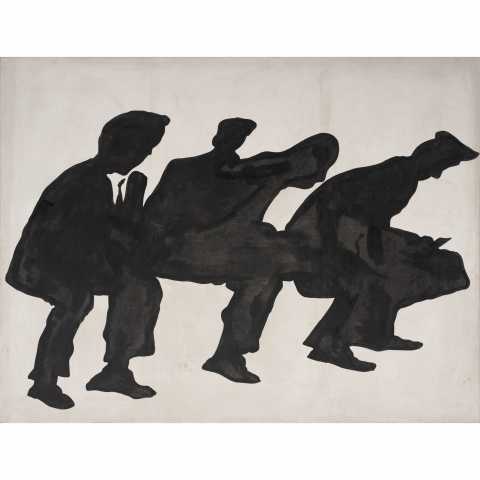Sprovieri
27 Heddon St
London
W1B 4BJ
United Kingdom

SERGIO LOMBARDO
Gesti Tipici and Monochromes
28 apr - 17 jun
preview 27 apr 6 - 8 pm
tue - sat 10 am - 6 pm
Sprovieri is proud to present Gesti Tipici and Monochromes, the first solo exhibition of Italian artist Sergio Lombardo in London.
Psychologist and artist, Lombardo is one of the main Italian artists who have renewed the European and International artistic language since the late fifties. The exhibition juxtaposes a selection of paintings from two early series - Monochromes (1958 -1961) and Gesti Tipici (1961-1963). The series are historically subsequent and, despite taking abstract versus figurative, have a strong common language. Employing an industrial medium like enamel and the use of black and white only, they convey the artist's understanding of industrial and mass production aesthetics, which were generated by the fast economic growth of the time and the imagery created by black and white television.
'Sergio Lombardo recalls of his first exhibition at the Roman gallery La Tartaruga in April 1963, 'some people told me they dreamt the Gesti Tipici for weeksâ€. Frequently linked to Pop art, the series of large-scale dichromatic paintings on show presented the recognisable silhouettes of political figures and ordinary people performing what he defined as something 'typical' or generic.
Lombardo's involvement with La Tartaruga - legendary meeting place, and synonymous with the group of artists known as the Scuola di Piazza del Popolo - began in 1961. Lombardo was heir to Futurism and to a visual language still attached to the pre-war, to tradition and a social kind of realism kindred to the black and white, mid-century Neorealist Cinema of Rossellini, Visconti and De Sica. Following a period of traumatic recovery and Marshall aid in WWII's aftermath, by the early 1960s Italy was on the brink of a so-called economic miracle, which encouraged a vigorous change in attitudes. Though Lombardo and the others were at the forefront of artistic innovation, he recounted, 'we were considered as an insane group of subversive agitators, especially from the artists of Realismo Socialista, like Renato Guttuso and his followers: they were the establishment.â€
In this context of deep seated academicism, monochromatic painting had a particularly symbolic value, as part of the anti-establishment. Lombardo explained that while producing his monochromes, 'I dedicated myself to a strictly technical and logical painting [..] as to produce works that were explainable and wholly controlled.†Reflecting an expressive abstinence, his works become scientific enquiries into modes of perception, attained by systematizing production, and switching the emotional lexicon of abstraction with the cool and measured aesthetic of the grid. When Lombardo began introducing figures into his enamelled canvases with Gesti Tipici, his investigation reached a turning point. He produced his works by projecting images cropped from newspapers or magazines onto canvas. As colour television didn't exist, and colour print was rare, his images were at first only black and white, coldly mimicking the prevalent mass-media aesthetic. In the artist's own words, the 'nocturnal visions' that resulted were the opposite of representational: they sought to drain the most evocative image of all its signification leaving only a shadow behind. The politicians that often appear - from JFK, to Malcolm X - are not portrayed but mass produced instead.
'Because modern man was attacked by the perceptive images of advertising, of cinema, of the press, of the machine (we are no longer allowed to speak of aggression, but rather of assimilation), he has lost his individual domain and has become absorbed in an infinite roster of free-for-all ready-made behaviours.†He points to how images have turned us into standardised beings, whose behaviour is predictable, determined.
This short localised history shows how Lombardo's work resonates far beyond an international dialogue with Pop. Lombardo's counter-attacks on the media were certainly enough to 'agitate' those still connected to the socially engaged and emotional art produced since Fascism. His Gesti Tipici left viewers with indelible images (and lasting dreams) of the darkened silhouettes that populated the canvases performing 'typical' gestures, which were ultimately anything but commonplace†(text by Sofia Gotti, 2016)
Sergio Lombardo (born 1939) lives and works in Rome. In the late 50's he was an exponent of the Nuova Scuola Romana (New School of Rome) and he was the leading figure of the international historical avant-garde and of the Italian Pop Art. He is the father of the Eventualist Theory, that led to an important artistic and theoretical movement based on experimental methods. Exhibitions of his works include the National Museum of Modern Art in Tokyo (1967), the Jewish Museum in New York (1968), the Centre Georges Pompidou in Paris (1969, 1995), the Walker Art Center in Minneapolis and the Dallas Museum of Art (2015). His work was included in the Tate Modern exhibition 'The World Goes Pop' in 2015-2016 with two paintings from the series Gesti Tipici. In 1970 he was given a personal room at the Central Pavilion of the Venice Biennale.
